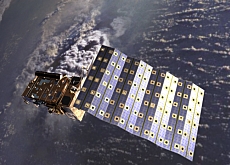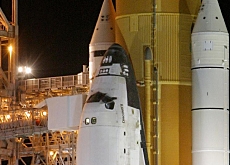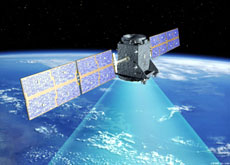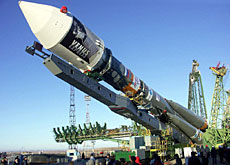New weather instruments give better forecast

The launch of MetOp-A, Europe's first polar-orbiting satellite dedicated to more accurate weather forecasting, has been delayed again.
The first of three MetOp satellites is carrying an array of high-tech mechanical, optical and electronic instruments to measure and predict the weather – including several made in Switzerland.
The launch from Baikonur in Kazakhstan was delayed 90 minutes before lift-off because of problems fuelling the Soyuz rocket. But despite the temporary setback, MetOp should prove to be a welcome boost for weather forecasting.
“A major step in the world of meteorology” was how Arnaud Gisiger, head of research and development at Syderal, a leading Swiss manufacturer of space electronics, described it to swissinfo.
MetOp-A – jointly established by the European Space Agency (ESA) and the European Organisation for the Exploitation of Meteorological Satellites (EUMETSAT) – promises to send back data of unprecedented accuracy and resolution thanks to its low orbit.
The satellite contains eight instruments and Syderal built instrument controllers for three of them.
These were: a scatterometer, which measures wind speed and direction; an infrared atmospheric sounder, which can measure temperature in three dimensions with an accuracy of one degree Celsius over a kilometre; and a microwave humidity sounder, which measures humidity and provides information for predicting rain.
However, Gisiger adds that the Swiss contribution to MetOp-A is on several levels.
“You have the structure, which supports the instruments, that is supplied by Contraves Space in Zurich,” he said.
“Then what we call ground support equipment, which is test [gear] made by APCO Techologies in Vevey, the IASI interferometer made by Swiss Center for Electronics and Microtechnology in Neuchâtel and then you have the electronics.”
Monopoly
Previously, the only source of meteorological data was weather satellites belonging to the National Oceanic and Atmospheric Administration (NOAA) in the United States.
“But the US could not provide or would not commit to send meteorological data to Europe on a regular basis,” Gisiger told swissinfo.
As a result, MetOp-A has been designed to work in conjunction with the NOAA satellite system: the European platform replaces the American “morning orbit” service while a NOAA satellite occupies the “afternoon shift”.
For Gisiger, MetOp-A’s chief advantage is its accuracy.
“When you do standard meteorology in geostationary orbit – like you have now for MeteoSat [EUMETSAT’s current satellite system] – it is usually used for predicting the movement of the clouds because you have only an accuracy of one kilometre. In low orbit, you have a one-metre accuracy,” he said.
A geostationary orbit is a circular orbit directly above the Earth’s equator – to an observer on the ground the satellite would not appear to be moving.
Such orbits – at an altitude of about 36,000 kilometres above the Earth’s surface – are useful for telecommunications relays as an antenna can point in a fixed direction and maintain a link with the satellite. However, distance reduces the accuracy of observations.
A low Earth orbit ranges from 200 to 1,200 kilometres above the Earth. MetOp-A will orbit at 800 to 850 kilometres.
“What is important with low-orbit meteorology is that you will be able to measure temperatures, humidity, ozone, pollution, wind and other parameters which you cannot do in geostationary orbit, ” Gisiger said.
“[At the moment] you can’t even predict rain very accurately.”
swissinfo, Thomas Stephens
Switzerland was a founding member of the European Space Agency, but it also collaborates with other agencies.
The Swiss space industry includes 28 research institutes and 54 companies. Apart from Contraves, all these firms have fewer than 200 employees.
They specialise mostly in ground equipment, optical apparatuses, telecommunications systems, clocks, robotic machinery, microgravity research, and weather surveillance.
Switzerland is also the homeland of Claude Nicollier, astrophysicist, test pilot and astronaut. He was the first foreigner granted mission specialist status by Nasa.
MetOp-A, the first of three MetOp satellites, will blast off from the Baikonur cosmodrome on July 18.
MetOp-A weighs four tonnes, is six metres high and carries eight instruments.
The Baikonur cosmodrome in Kazakhstan, built in 1955, is the world’s oldest and largest working space launch facility.
Russia has agreed to rent the cosmodrome until 2050 at $115 million (SFr150 million) a year.

In compliance with the JTI standards
More: SWI swissinfo.ch certified by the Journalism Trust Initiative




You can find an overview of ongoing debates with our journalists here . Please join us!
If you want to start a conversation about a topic raised in this article or want to report factual errors, email us at english@swissinfo.ch.